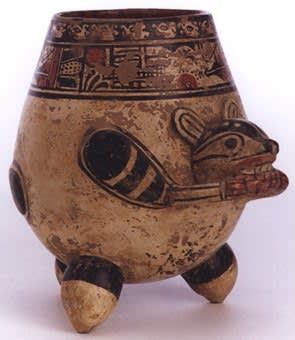Zoomorphic Effigy Vessel, 1200 CE - 1400 CE
Terracotta
8.25
PF.3567
During period VI, there was an increased production of white-slipped polychrome vessels in the northern part of the greater Nicoya sub area. The cream-slipped pottery was called Jicote polychrome. Although...
During period VI, there was an increased production of white-slipped polychrome vessels in the northern part of the greater Nicoya sub area. The cream-slipped pottery was called Jicote polychrome. Although Jicote painting on vessel has more matt quality than other styles, its designs are often bold and striking. This fascinating effigy vessel has the globular shape, which was popular in period VI, with round tripod supports. The band around the neck contains decorative patterns and zoomorphic figures, and the thin black contour lines define the shapes that are enhanced with orange-brown color. Such patterns seem to be symbolic expressions, indicating complex content. Moreover, it has an appliqué head of a rabbit eating a substance, which seems to be maize. With the head painted in a bold pattern and its large ears indicated, the rabbit holds the sustenance with its small hands. The body of the globular jar is cleverly used to suggest the roundness of the rabbit's form, and its legs and the tail are depicted with black paint. Intricately sculpted, the animal's position and the face are quite expressive--its large eyes are wide-open, absorbed in consuming the important sustenance. Being a mythical creature and a revered animal across the Meso-American continent, rabbit was a divine symbol often used by ancient Costa Ricans, as well as by Aztecs and Mayans. Decorated with such a special creature, this effigy vessel must have embodied a particular significance. As we contemplate this beautiful vessel, we appreciate the great ancient culture and its expressive, artistic creation.



